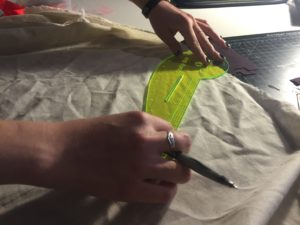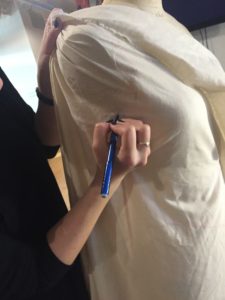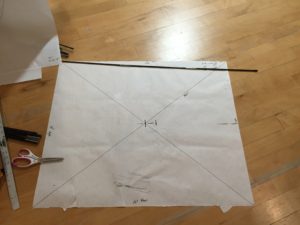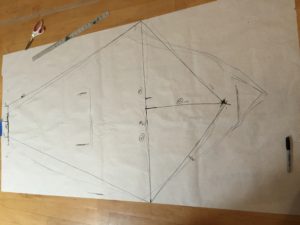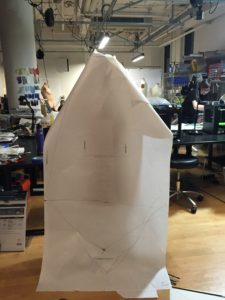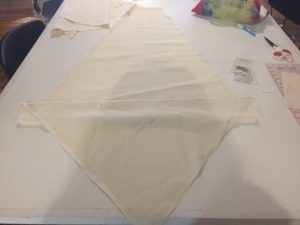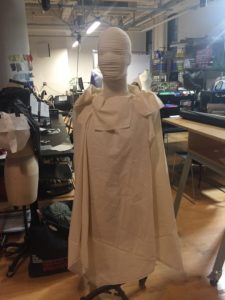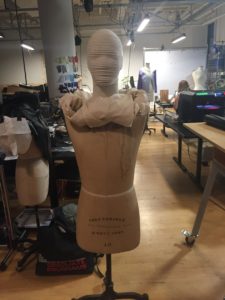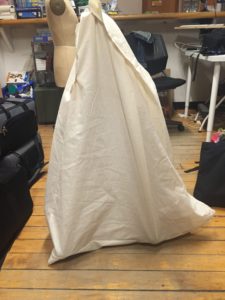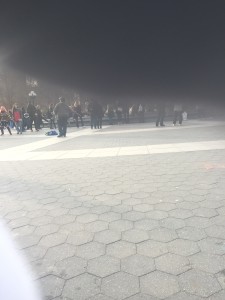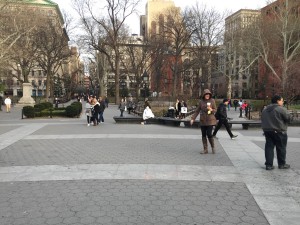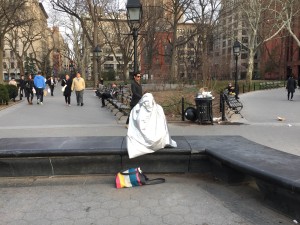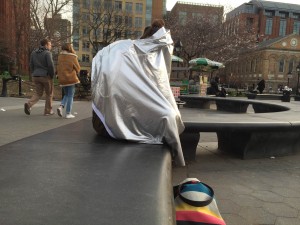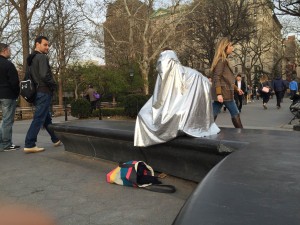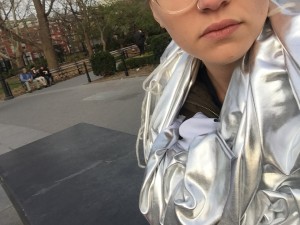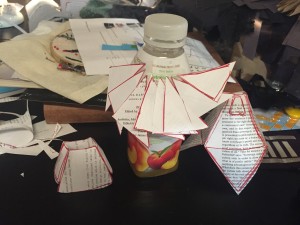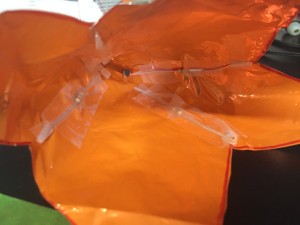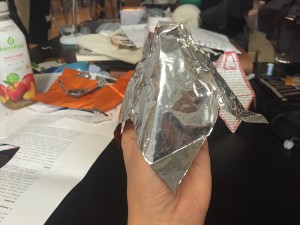Wearables: Pattern Making and Mock Up
After making small paper and mylar mockups, I started a couple weeks back on designing a full size prototype. I’ve never created a pattern before and while Teresa walked me through the basics, I had to improvise a bit because my garment stands away from the body.
Having a basic idea of the shape, I took four large pieces of paper and pinned them to the mannequin form and drew out the shapes based on the mockup. Knowing that I needed the four triangles at the bottom to meet as the floor, I took another piece of paper, sat on it, and tried to get an idea of what a good size would be.
I broke up the paper into the four triangles and used that to get some more specific measurements for the bottom shapes. Then I held a tape measurer and estimated a good height. I drew out shapes according to those measurements, and cut out my pattern pieces. I placed them back on the mannequin to make sure that everything lined up still.
I then used the patterns to create a muslin mock-up. Given that this is my first time making a garment from scratch, I only realized part way through tracing the shapes that I need to leave room for a seam and where exactly those seams should go. So I cut off the triangles from each side and went back over the patterns to indicate the addition of half an inch to all sides.
After I cut out all of my pieces I drew out the seam lines on each side of each piece. This technique, while time consuming, made my sewing go much more smoothly.
I sewed each side with its triangle, then three of the four pieces together keeping one side open so I could insert structuring materials. Overall, I’m pleased with the mock up. I didn’t sew all the way to the top – I’m trying to figure out a good distance to keep for a neck opening. Also, the flaps will act as a way of wrapping the extra fabric when it’s no longer in tent mode.
Temp Expert: Undersea Wireless Research
Found this really interesting article about how some students in Buffalo are developing a way to communicate wireless underwater. At the moment, most research institutes still use sound waves and radio signals.
“The reason for developing underwater wireless Internet isn’t so you can scuba dive and shop Amazon at the same time. Researchers hope that by improving underwater communication, they can make improvements in tsunami detection, pollution monitoring and offshore oil and natural gas exploration.”
From another article on their research:
“Land-based wireless networks rely on radio waves that transmit data via satellites and antennae. Unfortunately, radio waves work poorly underwater. This is why agencies like the Navy and National Oceanic and Atmospheric Administration use sound wave-based techniques to communicate underwater.”
Creating a undersea wireless network would improve current abilities to share data amongst different systems since currently each has a different infrastructure. Also, can use existing and planned underwater sensors to transmit data to laptops, smartphones and other wireless devices in real time.
So, glad that I came across this research because I could possibly find out about some cutting edge wireless research. I emailed Dr. Melodia and he said to contact him again in a week when he gets done with his travels. Turns out he’s actually at Northeastern, which is where my friend who studies coral is researching!
I also started reading about undersea animal communication. One of the most relevant take aways is that a noisy coral reef is a healthy coral reef. Couldn’t find info on whether or not certain frequencies are used for communication amongst coral or if certain frequencies affect them.
Cool video on coral reef noise:
http://www.huffingtonpost.com/2012/10/26/coral-reef-sounds-florida-erica-staaterman_n_2024566.html
sounds of healthy vs. unhealthy reefs:
http://www.smithsonianmag.com/smart-news/listen-sounds-dying-coral-reef-180953543/?no-ist
“Coral reefs are amongst the noisiest environments on our planet and healthy reefs can be heard using underwater microphones from kilometres away.”
Turns out that researchers at University of Exeter and University of Essex are doing a lot of research into the sounds of healthy vs unhealthy coral reefs.
From this article:
Dr Steve Simpson, from Biosciences at the University of Exeter, added: “Taking sound recordings is a cheap, fast and objective way to get a broad idea of whether a reef is in a good condition or not. While it cannot replace detailed visual surveys conducted by snorkelers or divers, it gives a good account of the cryptic and nocturnal species missed in visual census, and quickly provides a general picture of the state of coral reefs without requiring time-consuming surveys and extensive training.”
So, recording (and ideally, streaming) audio would be a way to monitor coral health and share this information with the average person. Now, I wonder if I would just keep the noise as is or try and translate it into a different sound or even a different output.
In any case, it sounds like scientists are very interested in developing tools related to reef health and acoustics.
ALSO:
Talk to my friend Dhruv about the basics of radio transmissions and he gave me tips on using a transceiver/receiver. Apparently transceivers are quite expensive (~$300), but he has access to one as does Benedetta. He also said I should email Oliver from Genspace and see what he thinks.
I emailed my friend at Northeastern again and asked her about what kinds of physical changes could be measured and what tools they already us to monitor.
RWET: Assignment 4
Today was the day I had to confront the very beginner like nature of my python coding skills.
Primarily because the assignment was to adapt a previous form of code that we had written and change the repeating parts into a function. In class this seemed fairly straightforward (and very useful).
So I returned to my midterm code [LINK]. I was thinking about breaking up the part that stripped the punctuation and the part that got rid of the boring words but I struggled with figuring out how the code would be broken up, because it seemed like everything was dependent on everything else – where do I make the breaks? Which, I guess is a lot of how code works. So how to make something modular.
I met with Allison and she explained that at their most basic, functions are a way of passing information in and outputting something else. Writing it here, it sounds so obvious. But taking these specific items of code and abstracting it into input and output was not quite as easy as I initially assumed.
A big part of my code was taking lists and altering them to make new lists. So we took the part of the code that stripped the punctuation and rewrote it as a function and then where it previously existed in the code we called what the function returned. Then we did this again with the boring words constructor function.
So far so good.
But rather than simply print the hardcoded Fib sequence as I had previously (print good_words[0], print good_words[1], print good_words[1], etc.) we tried to figure out a way that would take a number (n) and figure out the corresponding fib sequence number (so in this case, starting with 1: 1 = 1, 2 = 1, 3 = 2, 4 = 3, etc.). Use the properties of a list and a while statement to check each time if fib(n) was less than the length of lines, to print those lines and to break when it was more.
I added this to the bottom of the code, ran it in in terminal with sea_rose.txt and it worked!
harsh
harsh
rose
marred
petals
thin
precious
caught
crisp
Here’s the code:
Temp Expert: Communicating with Coral
After my unsure feelings and branching out last week, I took some time to re-visit all the different ideas that I’ve had so far for the project.
What I landed on was that I’ve been unsure about how to deal with this feeling of distance that I’ve been experiencing. How does one who has never visited a coral reef before begin to be able to speak to its existence? How do I decenter the human from my project – not wanting to speak for those who I’ve never met and not interested in putting myself at the center of this project, either.
Ultimately, I decided that it was the exploration of coral subjectivity and the natural network structures of coral that I find most compelling. I’ve been interested in network theory since before coming to ITP – how it exists as an abstract concept as well as a way of organizing telecommunications. Oliver actually brought this thought to my attention when we talked about my presentation. How the relationships amongst coral and the surrounding species sustain the diverse ecoysystem, how it is a nature-engineered balance with tipping points. That I should consider other ways of thinking about organized communication relationships, like Deleuze and Guattari’s concept of smooth vs striated space from “A Thousand Plateaus.”
So how to create something that re-inserts the subjectivity of coral, perform an ethnography of the coral subject. Based on Oliver’s recommendation, I want to take a look at the book, “How Forests Think: Toward an Anthropology Beyond the Human” by Eduardo Kohn. A summary: “Can forests think? Do dogs dream? In this astonishing book, Eduardo Kohn challenges the very foundations of anthropology, calling into question our central assumptions about what it means to be human—and thus distinct from all other life forms.”
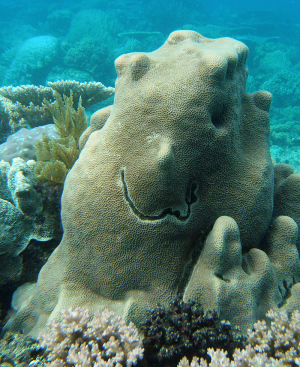
I feel that conceptually this direction is really strong, as it pushes me as an anthropologist beyond the human and enables me to further explore my technological interest in networked communication.
Now. What I really would love to do is find a way to bridge the distance between the us here in New York and Coral Reefs through telecommunication. I would love to see what a conversation between us and coral could look like. If coral could speak, what would we hear? What would we want to say back? What questions would we ask?
I was reminded of a the piece, A Hole in Space (Oakland Redux), by Ellen Sebastian Change that took place in Oakland this past year, where concurrent live streams of two different neighborhoods were projected in windows, creating the sense of one world sutured into another right there in the streets. No longer was it possible to ignore the decay and sirens.

My ideal project would be a way of installing a form of wireless communication in the vicinity of a coral reef and live streaming video/audio to several locations across New York City. Or installing some kind of visual that encourages passerbys to visit a page to see a livestream and send messages to the deep (using Twilio?).
I’m interested in how these messages can be encoded and translated…a bubble machine that emits bubbles based on morse code? Slight vibrations/waves? And is it simply capturing audio/visuals as they exist underwater or do they also undergo some kind of language conversion?

This idea reminds me of FutureFarmers Ethnobotanical Station (2012) project. Particularly the spade stethoscope.
 There’s also a possibility that these messages are directly connected to the ongoing physical conditions of the reef. Could this be a way for researchers to remotely track the health of reefs? Or could they be connected to sculptures used for artificial reefs and rehabilitation efforts?
There’s also a possibility that these messages are directly connected to the ongoing physical conditions of the reef. Could this be a way for researchers to remotely track the health of reefs? Or could they be connected to sculptures used for artificial reefs and rehabilitation efforts?
Also interesting is the presence of undersea cables, through which 99% percent of international data is transmitted and the long history of undersea cables for telecommunications but our lack of actual dialogue with the creatures whose ecosystems they lie in.
So as it stands, I propose creating a wireless communication device that enables humans to speak with coral and a way for coral to speak back.
I like this idea of desire, longing that is present…wanting to speak with someone but unable to reach them.
RWET: Assignment 3
I have to say, I feel like this is the first time since I’ve gotten to ITP that I’ve actually understood APIs and JSON. That being said, I wanted to make sure I could actually get some data to work with so I spent a long time just building different search queries with the NYTimes Article API. However, I struggled to find something of particular…conceptual interests. After running a bunch of different combinations, I thought about the NYTimes Real Estate section. I thought about urban gentrification and Brooklyn. And then I thought about…space colonization. I guess I’ve had the anthropocene on my mind, and the very real possibility that we’ll one day have to start looking outwards for new places to inhabit.
So I tried mashing snippets from a NYTimes search query with a json file I generated from this subreddit.
I was able to get both sets of content (with a lot of wrangling on the subreddit json trying to figure out how to access the post content) (this stack overflow post helped with figuring out how to even make requests in the first place. But when I tried to use the mashup code that I’ve used in the past, I was only getting individual characters. Here’s that code:
https://gist.github.com/zoebachman/4d90a8032095eb05bc2c2f5cb71907a3
While this is still something I want to debug (perhaps there’s a problem with the line recognition?), I also wanted my poem. I saved each set of content in separate text files and tried opening them in the code. Here’s one of the outputs:
Sales are about to begin at the Baltic, an 11-story condominium rising on the corner of Baltic Street and Fourth Avenue in Park Slope, Brooklyn.
First, locate a good, easily terraformable or habitable planet in the target system (it doesn’t need minerals, but that’s a bonus). Second, ship infrastructure to the planet. Civilian colony ships will begin delivering colonists. Third, set up automated mines and mass drivers on rich planets in the target system. Set the mass drivers to deliver to your main planet.
The actress lives with her husband, the chef Gabriele Corcos, in Windsor Terrace.
The actress lives with her husband, the chef Gabriele Corcos, in Windsor Terrace.
Though at this point it’s taking freighters from the fringes about 9 months to make the trip to earth and 18 months round so I’m not sure how sustainable this is. But nothing has really shown up to make me want to commit to a forward military maintenance base anywhere in my empire.
The sale of the group’s headquarters, along with two other properties owned by the Witnesses, has the potential to bring in $1 billion.
First, locate a good, easily terraformable or habitable planet in the target system (it doesn’t need minerals, but that’s a bonus). Second, ship infrastructure to the planet. Civilian colony ships will begin delivering colonists. Third, set up automated mines and mass drivers on rich planets in the target system. Set the mass drivers to deliver to your main planet.
The hosts of the new Cooking Channel series “Extra Virgin Americana,” live in a Brooklyn townhouse.
Do people set up outposts just for the sake of claiming systems, even if they’re useless?
With New York City real estate prices skyrocketing, new services aim to help city dwellers decide whether to move beyond the five boroughs.
Can I just leave fuel and ordinance on the planet? I can’t think of any facility that houses fuel/ordinance on earth technically…
Sales are about to begin at the Baltic, an 11-story condominium rising on the corner of Baltic Street and Fourth Avenue in Park Slope, Brooklyn.
im a bit of a noob, so i want to say thank you for your advices 😉
The sale of the group’s headquarters, along with two other properties owned by the Witnesses, has the potential to bring in $1 billion.
With New York City real estate prices skyrocketing, new services aim to help city dwellers decide whether to move beyond the five boroughs.
Can I just leave fuel and ordinance on the planet? I can’t think of any facility that houses fuel/ordinance on earth technically…
Woody Guthrie, in writings uncovered by a scholar working on a book, railed against Donald J. Trump’s father, Fred, or “Old Man Trump,” who was his landlord.
In the above I’m not super excited to dedicate resources to building up a colony that can support 25M or more colonists…should I just drop a few automated mines and a deep space listening facility?
Or another (shorter) one:
The actress lives with her husband, the chef Gabriele Corcos, in Windsor Terrace.
In the above I’m not super excited to dedicate resources to building up a colony that can support 25M or more colonists…should I just drop a few automated mines and a deep space listening facility?
Complaints about train vibrations, unruly guests and black chimney smoke.
The sale of the group’s headquarters, along with two other properties owned by the Witnesses, has the potential to bring in $1 billion.
im a bit of a noob, so i want to say thank you for your advices 😉
The hosts of the new Cooking Channel series “Extra Virgin Americana,” live in a Brooklyn townhouse.
Do people set up outposts just for the sake of claiming systems, even if they’re useless?
With New York City real estate prices skyrocketing, new services aim to help city dwellers decide whether to move beyond the five boroughs.
Like one of the systems adjacent to Sol I found has 1 barely habitable planet, no moons and no particular mineral concentrations. I haven’t surveyed the potential jump points yet, but assuming I find some…does it behoove me to set up a colony?
And another remix:
Sales are about to begin at the Baltic, an 11-story condominium rising on the corner of Baltic Street and Fourth Avenue in Park Slope, Brooklyn.
In the above I’m not super excited to dedicate resources to building up a colony that can support 25M or more colonists…should I just drop a few automated mines and a deep space listening facility?
Though at this point it’s taking freighters from the fringes about 9 months to make the trip to earth and 18 months round so I’m not sure how sustainable this is. But nothing has really shown up to make me want to commit to a forward military maintenance base anywhere in my empire.
This week’s subjects include shared electric bills and strict rules in co-ops, and problem in rent-stabilized apartments.
First, locate a good, easily terraformable or habitable planet in the target system (it doesn’t need minerals, but that’s a bonus). Second, ship infrastructure to the planet. Civilian colony ships will begin delivering colonists. Third, set up automated mines and mass drivers on rich planets in the target system. Set the mass drivers to deliver to your main planet.
Woody Guthrie, in writings uncovered by a scholar working on a book, railed against Donald J. Trump’s father, Fred, or “Old Man Trump,” who was his landlord.
Co-op liquidity requirements, running out of hot water, and circumventing a no-pet policy.
With New York City real estate prices skyrocketing, new services aim to help city dwellers decide whether to move beyond the five boroughs.
Do people set up outposts just for the sake of claiming systems, even if they’re useless?
Temp Expert: Possible Variant Paths
Since my presentation, I’ve been exploring some ideas that had come out while during my research but hadn’t quite made it into the current project idea that I have.
I started by looking at inter-coral communication and the idea of plant subjectivity. My mind makes the connection to post-humanism, how those who are not white/western/hetero/male subjects are often made to feel dehumanized. What connections exist amongst the ignored coral and the people who most acutely feel the effects of their disappearance?
But I can’t help but think about my positionality and what my relationship is to these events. I’m not interested in using the narratives of others to construct a project, but I also want to be inclusive of them. As a young, white woman living in the global north – how can I talk about coral bleaching, the influence of colonial practices.
I’ve been reading about initiatives to increase the role of woman in fisheries and marine conservation efforts. There’s something here about gender equality and stewardship that I find really interesting and wonder how I can incorporate this as an aspect.
I’ve been reviewing all of my research and notes and hit on the themes that I want to communicate:
Non-human subjectivity
Post-human ideas of subjectivity – both who is traditionally excluded from the category “human” and thus denied rights and agency
Network/communication
visualizing/materializing the unseen and unconsidered
expanding out to greater ideas of whitewashing/anti-diversity == homogenization culturally/biologically // colonialism
Resiliency
I’m struggling with a lack of deep connection to my idea and am trying to figure out how I can take some of the more interesting concepts and translate them into a new project idea.
Some more thoughts:
[>> possibly moving more into the realm of performance]
how to get past the distance
is it myself, acknowledging my position
what is my relationship to this subject
[thinking about that performance, with the lotion….hadn’t even really though of that]
taking white sunscreen
engaging with people in other cultures
getting past this distance
So in actual words, I think I want to explore my position in relation to this situation or at least acknowledge it.
One thought that I’ve had recently is digging into this interesting idea that sunscreen contributes to coral degradation. It just sounds so sad, but is also so specific.
I started looking into Oxybenzone, a chemical has toxic effects on young coral that causes endocrine disruption, DNA damage and death of coral, among other the problems. Oxybenzone also exacerbates coral bleaching, a process by which coral reject symbiotic organisms and lose their color (http://time.com/4080985/sunscreen-coral-reefs/).
For me, the kicker is that sunscreen is (typically) used by those (like me) with fair skin. Those that travel to tropical, exotic locales. Tourists that visit coral reefs.
Interestingly enough, there’s been a re-awakening of people towards coral bleaching. I’ve seen several articles and videos posted online recently discussing the coming destruction of the Great Barrier Reef. Obviously this is distressing, but it is interesting how most mainstream, even global coverage of coral death focuses on the Caribbean and Australia, which I think further hits upon the pre-occupation with how this crisis affects particular areas of the world.
Temp Expert: Making Museums Moral Again
“When the artists go, resistance goes, and rebellion is the foundation of interesting art and a moral life.”
I was skimming the recently assigned article (http://www.nytimes.com/2016/03/17/arts/design/making-museums-moral-again.html?_r=0), very intrigued. For one, I used to think my path lay in museum studies. I’ve love museums my entire life. As a child I’d beg my parents to take me to museums. When I realized I moved to NYC I was excited to get that much closer to my goal of being the kids in the mixed up files of Ms. Basil E. Frankweiler no joke. My first internship was at the met and my first job out of college was working in a contemporary art museum’s education department.
Now I find myself as a community organizer, activist and artist. I’m friends with the folks in Not An Alternative and Occupy Museums. Part of the reason I left the museum field was because of frustrations with the institutions, the capitulations to donors who often carried their own interests above the publics. My sister is currently working with a social practice artist at the Philadelphia Museum of Art and has on more than one occasion considered quitting over museum politics interfering with the project’s aims.
I’m currently working with the illuminator, a projection collective that “shines a light” on social justice issues. Some members of the collective were actually arrested for an anti-Koch brothers piece projected on the outside of the met.
[Gentrification is reality in new york.] The Illuminator is currently part of the Agitprop! show at the Brooklyn Museum, along withh Not an Alternative and Occupy Museums. There were protests at the BMA last fall because they hosted a realtors conference that was pro-gentrification. The current director is the former head of Creative Time so takes issues seriously, listened to the artist and organizers and decided to devote a room in the show to the protests, allowing the commentary of the institution to exist within the institution. We’re creating a documentary that asks how museums exist for the public good.To return to the quote above, the sentiment feels weak to me considering the aims of this piece. Rebellion is the foundation of interesting art and a moral life? This sounds like some bourgeois milquetoast bs, just the kind of upper class diction that’s pervasive in these institutions. “Oo wouldn’t a rebellion just be fun and its enough to remind us that we need to be decent human beings.”
Unfortunately as it stands, old guard institutions like the Met stand more for authority and commodification than risqué, rule-breaking and thought-provoking experiences. And that’s because they still cater to their old funders and donors.
Wearables, Wk 8: Park and Prototypes
PARK USER TESTING:
Last class last week, Despina gave me the advice to stop fussing over construction and to take one of the prototypes out for a test spin in a public place.
So, today I went to Washington Square Park and sat under my prototype for close to an hour. Here are my notes and impressions:
Sitting in Washington Square Park – a place with tons of people. Can sneak off an find a space to oneself. I sat near the fountain, where there are lots of people. I pulled the garment out of my bag, along with a book and my phone. I put it over my head and immediately noticed that I need to work on the transition – either it’s something that can be carried and then worn or worn and then expanded. Also if I’m already wearing it, making it so that the reflective aspects can’t be seen at first.
I feel like I just put on a costume.
People near me noticed, but went back to what they were doing.
Is ignoring weird strangers a New York thing? A Washington Square Park thing?
For a moment when I was walking to the park I was worried that people would perceive me as a threat – something terrorist related. Again – why do people find hiding threatening?
Thinking about being inside the garment – definitely want more space in front of the face, neck and chest. Definitely should be longer. Would like the ability to sit on it it, have some kind of “floor” in between me and the ground surface.
Thinking about a veil that can be let light in or out.
Definitely feel hidden away inside, not thinking about what’s happening outside of me.
“What’s in there?” – someone outside
I think piped in music (through built in speakers) may be better for noise blocking purposes, but maybe that leave me feeling too exposed?
Want to create some kind of exoskeleton so I don’t feel like it’s simple fabric resting on my head. Thinking back to tent poles.
Turning the garment around so my face is hidden, not tempted to engage with outside world.
Could this be a way of meditating?
Need to try with more insulation – light blocking and black microfleece.
I do like the current ability/choice to have natural light come through.
Wind makes it blow around a lot – might change with heavier fabric – and if I create that floor. Interested in weighing it down?
Maybe a different shape so my neck isn’t bent over the entire time. How can I sit up more full within it?
Definitely more soundproofing.
Does this make me more worried that they’re paying attention? Or do I want the attention while remaining in my private world? (YES)
Stretchy quality is nice, can really wrap and move it around.
Allows me to be the one listening in on people…Able to focus better. Read for over half an hour.
When I took the garment off, It was super easy. Wonder how that will change if I try to engineer some kind of retraction.
“Whoa, the world.” (my first thought after it took it off)
More appreciative of humanity and my surroundings – seeing things with fresh eyes. Feel calmer, less anxious, more at peace.
Think I’ll make it so the interior shows then it’s small, less conspicuous and more of a surprise when it expands.
Photos: Skylar Jessen
PAPER PROTOTYPING
So with those thoughts in mind, I came back to the floor and started paper prototyping some designs. Thinking about how I can expand space, make it more architectural, create a floor.
I started with making just a basic version, similar to the style I’ve been prototyping with muslin. Then I did a larger, longer one with flaps on four sides that can be folded into the bottom for a ground cloth. Lastly, I made a way more intricate design that involved various size triangles – the thought being that the different cuts would allow the garment to easily shrink down and then expand out. However, it seemed like an overcomplicated design and it didn’t provide as much space as the second design.
I then took some Mylar and using the second paper prototype as a stencil, created a mini mylar prototype. I used resistors to stand in for the tent pole design that I’m trying to think up next.
RWET: Midterm
I like form. I find constraint to be an interesting mechanism for producing art, producing results we often could not have come up with consciously. That being said, the use of form has often directly related to ideas of personal expression and emotion, a way of structuring the subconscious or revealing an underlying architecture.
While thinking about poetic form, the relation between logic and nature I kept hitting on integer sequences in math. The most well known is the Fibonacci sequence, the one where the next number in the series is created from the previous two.

The Fib sequence is particularly revered because not only does it come up in lots of different mathematical explorations but in nature as well. Golden spirals/ratios are seen in seed patterns, leaf placement and even faces. It’s an example of the underlying logic of what may seem like random chaos.
I went through a lot of different ideas about what the source text could be, initially wanting to play with ideas of logic and emotion. But as I kept referring to Fibonacci as Gib I thought, what if it was specifically fibs, lies, that the program altered? A quippy play on words, fibbing fibbers and the fibs they tell…in fib sequence?
Some months back On The Media did a whole show about Political Lies. Politicians often get away with political lies because people don’t bother to fact check and then when they do, the first-impression, the lie, is still stronger than the truth. The lie is what people remember.
So I was curious about what kind of poetry could emerge using the Fibonacci sequence on some of the recent political speeches, as we are currently in the heat of the presidential primaries.
CODE, ATTEMPT 1:
I started by writing out my ideas for code in plain english

I then realized that I should use lists, so I went back to the list code examples and played around with different examples that I thought would be helpful. After a few tries I came up with this code:
I showed the poems to my friend and it was pretty amazing how easy it was to guess the candidates from just a few words.
Ted Cruz, Remarks to the RedState Gathering in Atlanta, Georgia (August 8, 2015)
(from: http://www.presidency.ucsb.edu/ws/index.php?pid=114768)
Wow!
God
God
bless
RedState.
thank
that
unbelievably
Let
of
much
in
of
their
the
the
Supreme
Donald Trump, Remarks Announcing Candidacy for President in New York City (June 16, 2015)
http://www.presidency.ucsb.edu/ws/index.php?pid=110306
Trump:
Wow.
Wow.
Whoa.
That
some
people.
you
It’s
wonderful
like
big,
in
beating
from
of
now.
we
all
protect.
Member:
Bernie Sanders, Remarks Announcing Candidacy for President in Burlington, Vermont
(May 26, 2015)
http://www.presidency.ucsb.edu/ws/index.php?pid=110221
Thank
you
you
all
very
for
and
that
as
as
and
also
state
Super-PACs
change,
game,
median
us
senior
Clinton, Remarks in a Campaign “Kickoff” Speech in New York City (June 13, 2015)
http://www.presidency.ucsb.edu/ws/index.php?pid=110267
Thank
you!
you!
Oh,
thank
all!
so
is
you.
friends,
be
America,
the
America:
had
repairs…
powerful
politics.
I was slightly frustrated that for the sparseness of the text, many of the included words were “useless” or boring. I remembered that Nicole had a similar problem in an earlier assignment, which she solved through creating a list of “boring words” and if the code ran into one of these words to skip it. I asked Nicole if I could look at her code and went about adapting aspects to work with mine.
After running into some bugs (that in the end had little to do with that part of the code), I was able to get most of the “boring words” out. Except for the ones attached to punctuation.
Zach and I sat together and tried to use the .strip(‘”,.;:?!’) method that he had in his code. We ran into some issues of the possibilities of certain data types, like lists vs strings. With some moving around of different for loops we were eventually able to get rid of all the punctuation except for apostrophes and dashes. Offending words such as ‘that’s’ were added to the boring words text file to ensure they would not be present in the final text.
Here’s the code:
and a couple of examples.
**ok, my code started freezing up in terminal. I was able to parse one text, but after that the program keeps freezing. When I quit the program it says it’s having a problem with line 25, where the boring words are.
But honestly – looking at the following Cruz example using the same sample text as above:
Wow
God
God
bless
RedState
thank
extraordinary
you
conservative
you’re
Wow
you’re
you’re
Thank
consists
how
think
emailed
The lack of punctuation gives for a very different reading.
(Also I’m wondering if you’re should be on the boring list because 3 occurrences?!)
I decided to add back in exclamation and question marks to the punctuation and ran some more text, including op-eds in addition to speech transcripts.
Here’s one of Trump’s speech in Dallas,
https://www.facebook.com/MattWalshBlog/posts/1040241006009009
Wow
Amazing
Amazing
Amazing
thank
So
you
Teleprompters!
so
old
call
I
do
Dallas
And the Cruz speech is vastly improved from the last iteration, thanks to the return of exclamation marks:
Wow!
God
God
bless
RedState
thank
extraordinary
you
conservative
you’re
Wow!
you’re
you’re
Thank
consists
you
Wow!
We
home
bless
Or this one from Virginia,
Ted Cruz, Remarks Announcing Candidacy for President at Liberty University in Lynchburg, Virginia (March 23, 2015)
(from: http://www.presidency.ucsb.edu/ws/index.php?pid=109774)
Good
see
see
you
Good
you
you
you
you
see
Good
you
God
President
university
so
you
Italian
drank
children
She
pioneering
THOUGHTS:
In the end, the poems conform to the proposed form of using the Fibonacci sequence.
However,
I do with that they were visually stronger. Part of the reason I like the Fibonacci sequence is it’s exponential growth, seen in the Golden Spiral.
I tried to think through some ways that I could achieve this, but kept getting caught up in equating integers and words or strings (irregardless of Python types!). How does one add together words in somewhat sensical ways? Is it possible to parse a script when the numbers evolve exponentially so quickly that it’s difficult to equate to string characters or words?
Perhaps this is where the human hand could better come into play. Possibly it would be punching up the visual aspect. Zach and I joked about placing them in a spiral formation.
Also – why is it taking so long for the program to run in terminal?
Temp Expert: Ceramic Coral Reef
Hey, look at this cool ceramic coral project:
